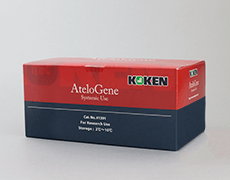Newsletters
AteloGene for miRNA transfection in a diabetes model
31 January 2017
In this edition of the newsletter, we describe a paper in which miRNA mimic/miRNA inhibitor was administered to the pancreas of an insulin-deficient mouse model of diabetes using AteloGene Systemic Use.
Transfection of miRNA/miRNA inhibitor into the pancreas by systemic administration
Article information
MicroRNAs 106b and 222 Improve Hyperglycemia in a Mouse Model of Insulin-Deficient Diabetes via Pancreatic β-Cell Proliferation.
Tsukita S, Yamada T, Takahashi K, Munakata Y, Hosaka S, Takahashi H, Gao J, Shirai Y, Kodama S, Asai Y, Sugisawa T, Chiba Y, Kaneko K, Uno K, Sawada S, Imai J, Katagiri H.
EBioMedicine. 2017 Feb;15:163-172. PMID: 27974246
Overview
Type 1 diabetes is characterized by a progressive loss of pancreatic beta cells, necessitating lifelong treatment with insulin. β-cell depletion also has been reported in type 2 diabetes.
The authors, who had been conducting research on insulin therapy, previously showed that β-cells proliferate from bone marrow following transplantation into a mouse diabetes model generated by drug-induced β-cell injury.
A secreted factor, believed to be derived from bone marrow cells, was inferred to promote the proliferation of β-cells; however, the identity of this factor remained unknown.
Therefore, the authors analysed the serum exosome after bone marrow transplantation and identified miR-106b and miR-222 as miRNAs thought to be involved in regulation of β-cell proliferation.
The authors demonstrated that repeated (3-time) systemic administration of inhibitors of both miRNAs, together with AteloGene, in this mouse model resulted in an increase in fasting blood glucose level and a decrease in insulin level in the pancreas.
In contrast, repeated (3-time) systemic administration of a mimic of both miRNAs decreased the fasting blood glucose level for at least 50 days, while yielding increased insulin levels in the serum and pancreas.
Additionally, the authors used a fluores39cently labelled miRNA mimic to demonstrate increased miRNA accumulation following introduction into the pancreas using AteloGene.
AteloGene forms a complex with miRNA/siRNA and suppresses degradation of the miRNA/siRNA
Product name
– AteloGene Systemic Use (Cat. No.: #1393 for Cosmo Bio customers)
(Cat. No.: #1395 for REPROCELL customers)
